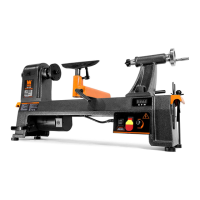TURNING SAFETY
1. This lathe is designed and intended for use by prop-
erly trained and experienced personnel only. If you are
not familiar with the proper and safe operation of a
lathe, do not use it until proper training and knowledge
have been acquired.
2. DO NOT wear loose clothing or jewelry. Keep your
hair, clothing and gloves away from moving parts.
Loose clothes, jewelry or long hair can be caught in the
spinning tool.
3. Select the right tool for your task at hand. Make sure
all tools, chisels and accessories are sharp before using
them. Do not use dull or damaged tools.
4. Select the appropriate speed for the task. Use slower
speeds when starting on a workpiece. Allow the lathe to
ramp up to the operating speed before engaging carving
tools.
5. Check the workpiece carefully for splits, knots, nails,
or other obstructions. These types of blemishes may
cause a safety hazard during turning.
6. If gluing up a workpiece for turning, always use a
high quality glue that meets the needs of the particular
workpiece to prevent the workpiece from falling off dur-
ing operation.
7. Rough cut the workpiece as close as possible to the
finished shape before mounting it on the lathe.
PERSONAL SAFETY
1. Operate in a well ventilated area. Keep the floor area
around the lathe level and free of slippery substances or
other tripping hazards.
2. Wear ANSI-approved safety goggles to protect your
eyes from sawdust. Use hearing protection to protect
yourself from hearing loss.
3. People with pacemakers should consult their
physician(s) before use. Electromagnetic fields in close
proximity to pacemakers could cause pacemaker inter-
ference or pacemaker failure.
4. Sawdust is harmful to your health. Use NIOSH-ap-
proved dust masks or other respiratory protection dur-
ing operation and cleaning.
5. Always turn off and unplug the lathe before making
any adjustments or repair tasks. Never adjust the lathe
or the workpiece while the lathe is running.
6. Do not use to cut metal, logs, tree limbs, or uneven
lumber. Inspect the workpiece and remove all nails and
other embedded objects prior to starting work.
7. Wet lumber, green (unseasoned) lumber, and pres-
sure treated lumber all have an increased potential for
kickback and should only be cut with a blade specifically
designed for that lumber type. Wear a NIOSH-approved
respirator and have appropriate ventilation whenever
cutting pressure treated lumber.
SPECIFIC RULES FOR YOUR LATHE
WARNING! Do not operate the power tool until you have read and understood the following instructions
and the warning labels.
6

